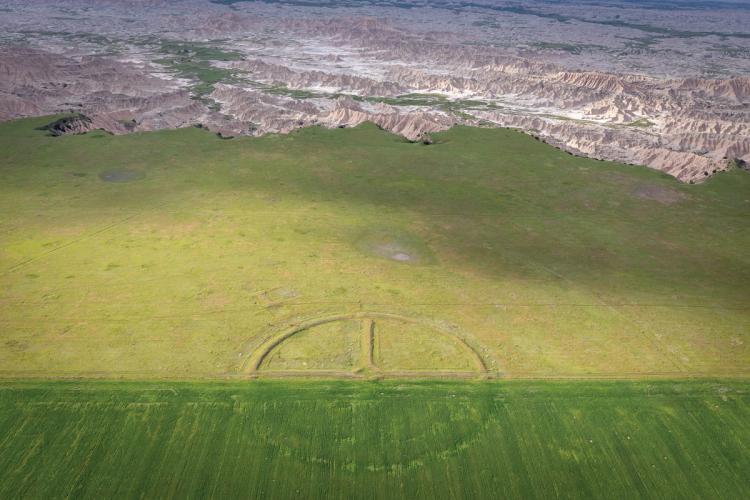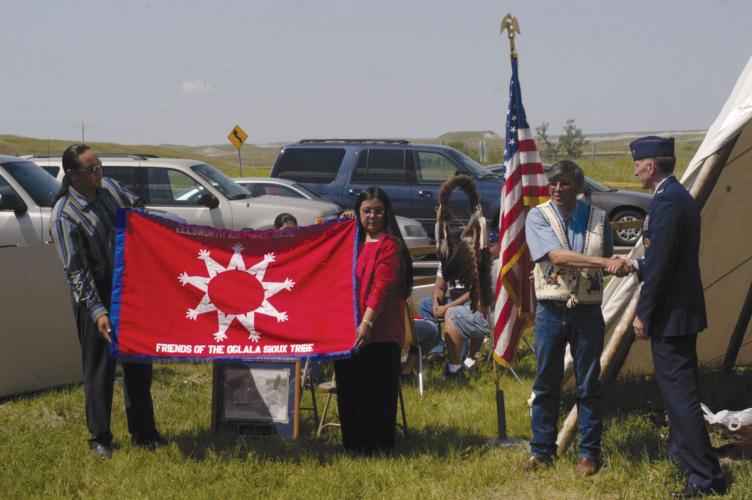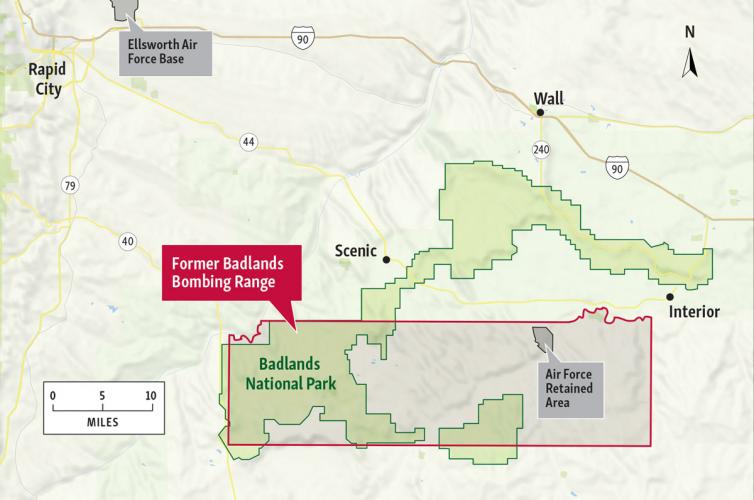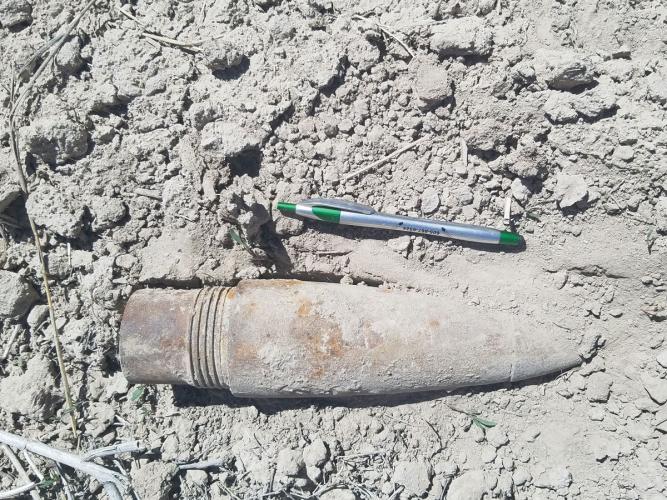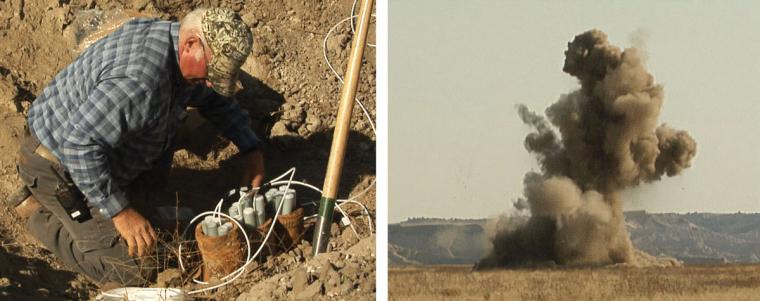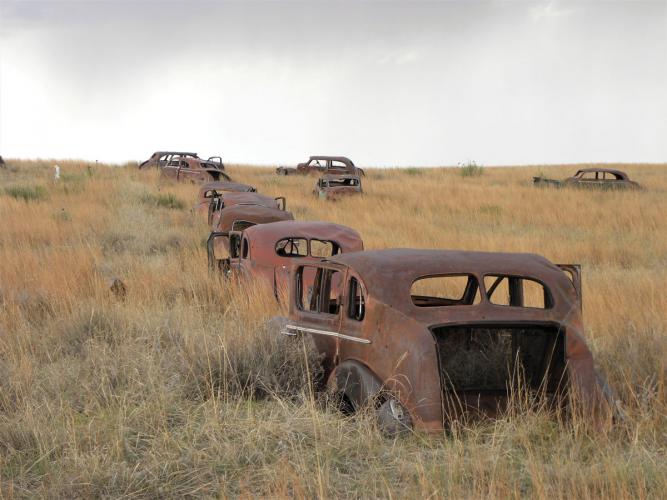Shawn Swallow vividly remembers the first time he detonated an unexploded bomb on his Pine Ridge Indian Reservation in southwest South Dakota. “It was scary,” he recalls. He thought, “It could go off. I could blow up.” The year was 2004, and he had been one of several men from his Oglala Lakota community who had volunteered to train how to dispose of unexploded bombs on a part of the reservation used for target practice during World War II.
Nearly two decades later, Swallow now heads the Badlands Bombing Range Program dedicated to cleaning up the military debris left on the land of the Oglala Sioux Tribe, his Oglala Lakota people. While primarily limited funding has led this work to be sporadic since the military stopped using the land after the war, this past summer his team resumed its methodical and sometimes dangerous tasks. After decades of disposing of unexploded bombs, Swallow’s teams have it down to an art. “You don’t get complacent by no means,” he said. “But you know what to expect and the precise things you need to do.”
Swallow grew up surrounded by his Oglala Lakota community. His family was one of many forced to leave the reservation to make way for the bombing range. During World War II, Canada’s Air Force and the U.S. Army Air Corps took land owned by at least six First Nations communities in Canada and 16 American Indian tribes in Alaska, Arizona, California, Minnesota, Nevada, New Mexico and South Dakota for use as practice bombing ranges. In the United States, they did so under the guise of “eminent domain,” which allowed the government to condemn or purchase land for the war effort. Military forces would use these lands to practice dropping bombs from planes and shooting ammunition at ground targets, leaving behind a scattering of debris that included shell casings and unexploded bombs.
After the war, some First Nations were given back their parcels of land and have won lawsuits against the Canadian government for not cleaning up remaining military pollution. The U.S. government also said tribes could have their lands back. But the ammunition contaminated the environment and made it unsafe for any person, wildlife or livestock to roam. In South Dakota alone, 38 military installations still have land contaminated by hazardous materials, including the former gunnery and bombing ranges along the northern border of the Pine Ridge Indian Reservation.
The Oglala Lakota people in the area were left with a mess that they then told the U.S. government it would have to address. “We will not take back land that is not clean,” said Swallow. Although the U.S. Environmental Protection Agency no longer classifies this area as a uninhabitable brownfield site, more than 80 years later, the Oglala Lakota people are still unable to walk safely on their own land.
Lost Homes
In 1942, the U.S. Department of War and Army Air Force took possession of 341,726 acres of land on the Pine Ridge Reservation to create the bombing range for military personnel in training. Despite Oglala Lakota and other peoples living in the area, the U.S. government deemed it “empty and useless.”
The Army seized their land, paying farmers and those living on communal Lakota land mere dollars an acre before relocating them. The July 7 to August 24, 1942, Tract Register for the Army Service Forces’ Office of the Chief of Engineers Real Estate Division lists 874 Lakota and non-Indian landowners (including some school and county sites) who had between half an acre to 960 acres seized. While land quality varied, Lakota residents were often paid less than a dollar to $8 per acre. Some who declined to participate reported having their land condemned and received no compensation. Some non-Native counties, schools and individuals, however, were disproportionately paid. For example, one Washington County School’s .53-acre tract of land sold for $1,035.
In the documentary “Darkest Night” produced by the Little Wound School on the Pine Ridge Reservation in 2022, Lakota elders describe what taking these lands did to their people. Some Lakota residents were told the Japanese were invading to encourage their rapid relocation. “They put fear into my grandma and other people that lived out there,” one elder recalled. Another remembered a story of those attending a church service on the last day they were on their land. “They were praying for a miracle where they wouldn’t have to leave,” he said. “While they were in the church, about 10 of those big bombers flew over … the church and dropped about 300 bombs onto a flat about a mile and a half away. That sure let them know it was time to leave.”
Most Lakota residents were given only 10 days to leave their homes, and in 1942, many did not have vehicles. Some would have to kill their livestock as they could not take them with them. Mickey Hartnett, a co-manager for the Kansas State University Technical Assistance to Brownfields Program, still has Lakota relatives living on the Pine Ridge Reservation. “They basically packed up what possessions they could on wagons and left,” Elders told him. They said they “abandoned their farms and homesteads.”
In spite of the danger, some refused to leave the reservation. However, the Lakota families who did relocate moved to other areas along its edge or away entirely. The small payments they received for their land were not enough for them to be able to buy new homes. Emma Featherman-Sam (Oglala Lakota), the first director of the Badlands Bombing Project, recalled, “It really was a sad time for these people that lost lands there. They feel that the government came in and took the lands without their permission.”
An August 1, 1942, letter from Under Secretary of the Interior Abe Fortas to Secretary of War Henry Stimson recognized the financial impacts upon the Oglala Lakota people: “The 8,500 Indians of the Reservation cannot permanently spare the 382,000 acres [sic] desired by the War Department without disastrous affects upon the tribe’s economy. This department is willing and anxious to obtain for the War Department the use of this Indian land at the earliest possible moment and at the lowest possible cost.” Fortas also requested assurance that the land would be returned to the Lakota people, yet this process would not begin until after 1975.
Misfires
This bombing range on the Pine Ridge Reservation was used extensively from 1942 through 1948 as air-to-air and air-to-ground gunnery ranges and for precision and demolition bombing exercises. Planes would fly the 50 miles from the Rapid City Air Base (now Ellsworth Air Force Base) near Rapid City, South Dakota. Most firing took place within the present-day South Unit or Stronghold District. Old cars and 55-gallon drums painted bright yellow served as targets, while bombardiers aimed at 150- to 250-foot-wide circular bullseyes constructed of raised earth marked with a cross. Visible from the air, some culturally important sites and hundreds of fossil resources were destroyed in the bombing, including some large fossil remains of the elephant-sized titanothere.
Not all firing was accurate. Many pilots in training had difficulty in defining the exact boundaries of the firing range. National Park Service accounts report that miles outside of the boundary, residents recalled that they had to dive under tractors while cutting hay to avoid bombs dropped by planes. In the nearby town of Interior, a church and the building containing the community’s post office had 6-inch shells shot through the roof. Oglala Lakota resident Marvin Cuny lived just outside the boundary of the bombing range. “They started a fire up there and we was fighting the fire,” he recalled. “We had to take off and run because about eight or 12 fighter jets flew over and started shooting at them barrels.” Although no people from the community died from the misguided attacks, another elder recalled having some of their horses shot by planes strafing targets. In addition, at least a dozen members of flight crews perished in training accidents.
After the war, the South Dakota National Guard used portions of the bombing range as an artillery range. The military finally stopped using most of the land in 1968, when the U.S. Army Air Force declared most of the range “excess property.” That year, the U.S. Congress returned 202,357 acres of the former range to the Oglala Lakota Nation and designated 136,882 acres as the Badlands National Monument, later renamed Badlands National Park. In 1978, all remaining badland Bombing Range lands were declared excess except for 2,486 acres on Bouquet Table, formally known as the Impact Area and renamed the Air Force Retained Area or Badlands Gunnery Range. This parcel was used for National Guard artillery practice between 1966 to 1973, and although retained by the Air Force, is no longer used by the military.
Bad Lands
The ground in and around the areas of the Oglala Lakota lands used for target practice became littered with discarded bullet shells and unexploded bombs, or ordinance, referred to as UXO. These are explosive or chemical munitions that were fired but did not activate. Throughout the Stronghold District, UXO ranges from small bullets to large bombs. Pieces of or entire UXO can be hard to locate because it can be only partially visible on the surface, covered by vegetation, snow or other matter, or even buried up to 20 feet below ground. Large explosive shells are occasionally found eroding out of the Badlands buttes. While some UXO can be physically removed, others require controlled detonation where they are found.
Since 1948, teams from several U.S. agencies, including the Air Force, Army Corp of Engineers, Department of Defense and the Environmental Protection Agency (EPA), have periodically surveyed and cleaned up sections of the range. In 1980, the EPA determined it was a “superfund” site and allocated additional funds for its cleanup. At first, the approach was to collect the debris and UXO and bury them in disposal sites on the reservation. Then in 1993, the Oglala Sioux Tribe established the Badlands Bombing Range Project funded by the Department of Defense.
While cleaning every square foot of the area is unlikely, plans were developed to remove all ordinance near inhabited or traveled areas. Teams had to receive specialized training in how to locate and map ordinance that was later removed through contracts with personnel hired by the U.S. Army Corps of Engineers. Hartnett was working at the EPA in 1995. He had extensive experience in cleaning up military sites, so he was assigned to spend several months locating ordinance dump sites on the reservation.
Several public meetings were held in local district halls to inform people of the efforts to return their lands and clear them of military and other debris. Hartnett recalled, “We had one public meeting that was on the reservation, and while we were showing pictures of some of the bombs that were dropped back then, someone came walking into the hall carrying a bomb and saying, ‘Is this one of them?’” The hall was quickly evacuated, and an Air Force bomb squad was summoned to dismantle the bomb.
From 1994 to 2006, the Technical Outreach Services for Native American Communities program in partnership with Kansas State University and Haskell Indian Nations University provided training for members of Native American communities near former military sites who wished to learn how to clean them up. Featherman-Sam oversaw the first UXO teams, including many Lakota veterans. From 2006 to 2014, 17 tons of material was collected from target areas, including more than 500 unexploded cartridges and bombs.
Now contained entirely within the Pine Ridge Reservation and co-managed by the National Park Service and the Oglala Sioux Tribe, the South Unit of the Badlands Bombing Range is considered the most dangerous. Christian Knutson (Oglala Lakota) has seen UXO on the land most of his life, as he grew up near the range and now serves as park ranger at the Badlands’ White River Visitors Center. “Nowadays, mostly you’ll find little casings and bullets from like the 20 mm,” he said. “But I have found a few bigger UXOs.”
Park visitors tend to avoid this area, which is farther away from major highways, more remote and less accessible, requiring a truck or travel by foot. So most discoveries of UXO in the South Unit come from back-country hikers or local ranchers who use several grazing areas in the unit for cattle and horses. Residents and visitors are instructed to heed posted UXO warnings and never to approach, touch or disturb any UXO, but rather to note the location and report any to staff of the visitors center.
This past summer, after several years hiatus from lack of funding and then the COVID-19 pandemic, Shawn Swallow’s teams resumed their work. They have conducted a visual inspection of areas and used metal detectors to look for anomalies on or below the surface. Once located, any munitions and explosives were recorded and targeted for removal or detonation.
Deep Impacts
Today more than 10,000 individuals are working on removing UXO across the United States, including on the lands of several tribal nations. Although few individuals who experienced the forced relocation from Pine Ridge firsthand are alive today, their descendants are still affected psychologically and financially by the loss of family lands. Although Lakota peoples were allowed to repurchase their lands starting in the 1960s, many could not afford to do so or had had established homes elsewhere. One U.S. Army Corps of Engineers report estimates that only about one-fourth of the land has been reoccupied by descendants of the initial evacuees.
“The people who were children back during that time are a lot of the elders now that come to our meetings,” Featherman-Sam said. “Some of those elders get up and they cry when they talk about what happened to them during that time.” Knutson said, “I do know that there is still a group of people here that view the South Unit as land lost.”
Although today some of the range is used for grazing and hiking and is inhabited by Lakota families, much debris remains to be removed and years of work still lay ahead. Despite numerous cleanup projects, a 2023 assessment still lists The Pine Ridge Gunnery Range and the Badlands Bombing Range as “medium risk” sites and UXO are still frequently reported. However, Swallow indicated that areas of high, medium and low risk still exist based on their proximity to homesteads. In 2019, planes using radar developed a topographic map that showed that 90 percent of areas with suspected UXO are located within 750 feet of an access road.
Swallow sees a day the work could be completed and said he feels as an Oglala Lakota tribal member that he is “obligated to clean it.” Yet he also said, “I don’t see it done in my lifetime” because of the cost and intermittent commitment of funding. To complete the job, he estimates, would take $17 million. Still, Swallow takes great pride in helping restore his tribe’s lands and protecting people. “Knowing that we took care of something that could have endangered somebody,” he said. “That’s the rewarding part.”

